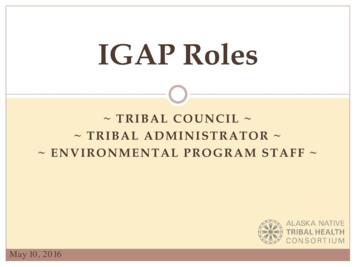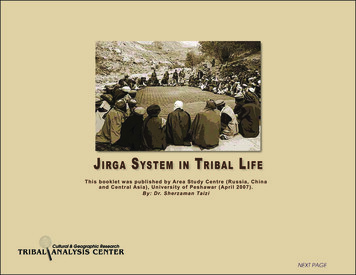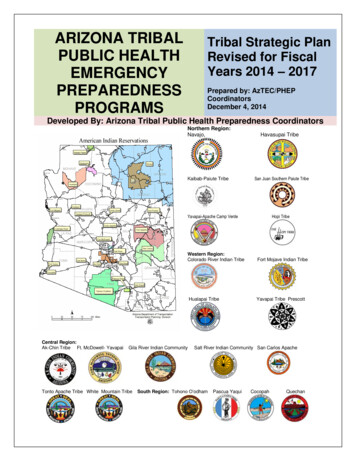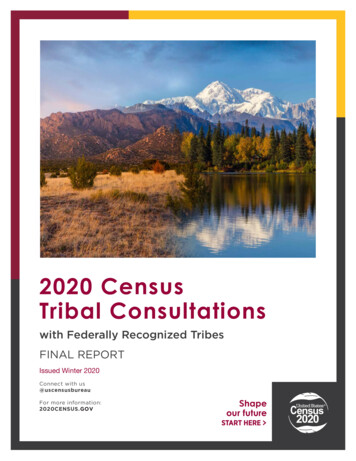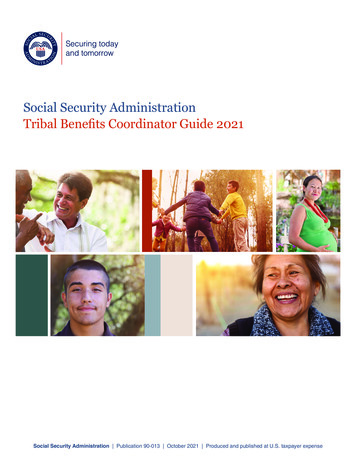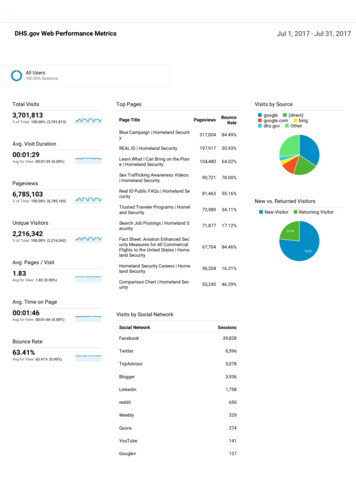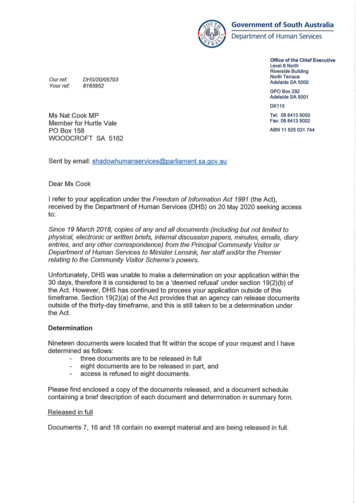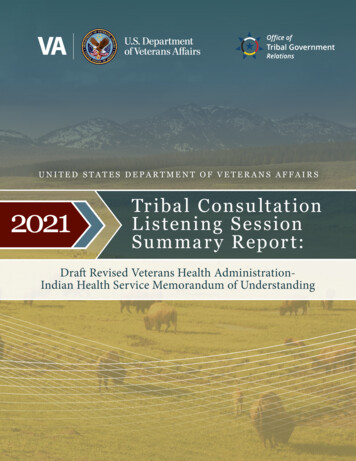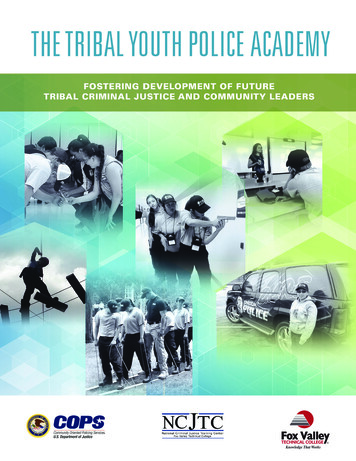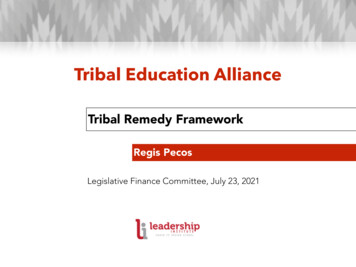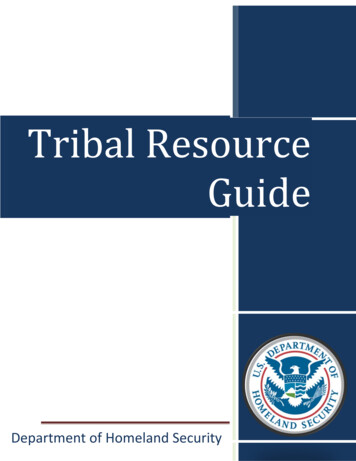
Transcription
Tribal ResourceGuideLast Updated June 2013Department of Homeland SecurityPage 1
Homeland security begins with hometown security. As part of its commitment to hometown security,the Department of Homeland Security (DHS) has worked to get tools, information, and resources out ofWashington, D.C. and into the hands of our federal, state, local, tribal and territorial partners.Tribal Nations are critical partners in our homeland security efforts, and DHS’s Office ofIntergovernmental Affairs (IGA) promotes an integrated national approach to homeland security bycoordinating and advancing federal interaction with state, local, tribal, and territorial (SLTT)governments. IGA is responsible for opening the homeland security dialogue with executive-levelpartners at the SLTT levels, along with the national associations that represent them.DHS’s Office of Intergovernmental Affairs developed this guide to highlight some of the DHS resourcesavailable to Tribal Nations to keep our nations safe and secure. This document summarizes andprovides links to training, publications, guidance, alerts, newsletters, programs, and services available toTribal Nations from across the department. This document is not exhaustive and will be maintained as aliving document. The resource guide is organized by component and resource type and serves as astarting point for locating DHS resources for Tribal leaders and their staff. A comprehensive index isavailable to facilitate locating resources.IGA is committed to working with our Departmental and interagency partners to provide the assistanceand support Tribal Nations require.Last Updated June 2013
Table of ContentsCustoms and Border Protection (CBP) . 1CBP INFO Center Self Service Q&A Database . 1National Gang Intelligence Center (NGIC) . 1CBP Border Community Liaison (BCL) Program . 1CBP Information Center . 2CBP State, Local & Tribal Liaison (SLT) . 2CBP Tip Line . 2Civil Rights and Civil Liberties (CRCL) . 3Civil Rights Requirements in Federally Assisted Programs . 3Community Roundtables . 3CRCL Impact Assessments . 4CRCL Newsletter. 4CRCL Facebook Page . 4Equal Employment Opportunity (EEO) Reports . 4E-Verify and Unfair Labor Practices Training . 4Forced Labor Resources . 5How to File and Submit a Complaint . 5Human Rights and Vulnerable Populations . 5Human Rights Violators and War Crimes Unit . 5Privacy, Civil Rights and Civil Liberties Fusion Center Training Program . 5Quarterly NGO Civil Rights/Civil Liberties Committee Meetings . 6Office for Civil Rights and Civil Liberties (CRCL) Quarterly and Annual Reports to Congress . 6Office of Cybersecurity and Communications (CS&C) . 7Multi-State Information Sharing and Analysis Center (MS-ISAC) . 7Critical Infrastructure Partnership Advisory Council (CIPAC). 7Information Technology-Government Coordinating Council (IT-GCC) . 7Cyber Security Evaluation Tool (CSET) . 8Cybersecurity Assessment and Risk Management Approach (CARMA) . 8Software Assurance Forum . 8“Build Security In” BSI . 8Last Updated June 2013
CyberStorm Exercise Series . 8National Cybersecurity Communications Integration Center (NCCIC) . 8United States Computer Emergency Readiness Team (US-CERT) . 9National Cyber Alert System (NCAS) . 9Industrial Control Systems Cyber Emergency Response Team (ICS-CERT) . 9National Cyber Security Awareness Month and Stop.Think.Connect Campaign . 9Government Forum of Incident Response and Security (GFIRST) . 10Domestic Nuclear Detection Office (DNDO). 11Radiological /Nuclear Detection and Adjudication Capability Development Framework (CDF) . 11National Incident Management System (NIMS) Preventive Radioactive/Nuclear Detection Resource(PRND) Type Definitions . 11Training . 11Exercises . 12Joint Analysis Center (JAC) . 12Federal Emergency Management Agency (FEMA) . 13Community Emergency Response Team (CERT) . 13DisasterAssistance.gov . 13Emergency Management Institute Programs (EMI) . 13Flood Map Assistance Center (FMAC) . 13Private Sector E-alert . 14Incident Command System (ICS) . 14Map Modernization Management Support (MMMS) . 14National Flood Insurance Program (NFIP) . 15National Incident Management System (NIMS) . 15National Response Framework (NRF) . 15National Training and Education Division (NTED) . 15Ready Indian Country . 16Emergency Lodging Assistance Program . 16Voluntary Private Sector Preparedness Accreditation and Certification Program (PS-Prep) . 16Tornado Safety Initiative . 16U.S. Fire Administration’s National Fire Academy (NFA) Training Programs . 17U.S. Fire Administration Publications . 17Last Updated June 2013
National Continuity Programs (NCP). 17Federal Law Enforcement Training Centers (FLETC) . 18Leadership and International Capacity Building Division / Leadership Institute Branch . 18Office of State, Local, Rural, Tribal and Territorial Training (SLRTT) . 18Office of Intelligence and Analysis (I&A) . 20Alternative Analysis Workshop . 20Basic Intelligence and Threat Analysis Course . 20Clearance Nominations . 20Critical Thinking and Analytic Methods Course . 20Homeland Secure Data Network (HSDN) . 20IC Tradecraft Standards for Analysts Workshop . 21Managing Analysis Workshop . 21Mid-Level Intelligence and Threat Analysis Course . 21Open Source Practitioners Course (OSINT) . 21Principles of Intelligence Writing and Briefing . 21Regional Analytic Advisor Plan (RAAP). 22State and Major Urban Area Fusion Centers . 22Vulnerabilities and Threat Risk Assessment (VTRA) Course . 22Immigration and Customs Enforcement (ICE) . 23Office of State, Local and Tribal Coordination (OSLTC). 23Blue Campaign to Combat Human Trafficking . 23If You Have the Right to Work, Don’t Let Anyone Take it Away Poster . 24Law Enforcement Information Sharing Services (ICE Pattern Analysis and Information CollectionSystem). 24Law Enforcement Support Center (LESC) . 24Resources for Victims of Human Trafficking and Other Crimes . 25Victim Assistance Program (VAP) . 25Homeland Security Investigations (HSI) Tipline Unit . 25Office of Infrastructure Protection (IP) . 26Active Shooter Resources . 26Business Continuity Planning Suite . 26Last Updated June 2013
Critical Infrastructure and Key Resource (CIKR) Asset Protection Technical Assistance Program(CAPTAP) . 26Critical Infrastructure Toolkit . 27Dams Sector Crisis Management Handbook. 27Emergency Services Self-Assessment Tool (ESSAT) . 27Food and Agriculture Sector Criticality Assessment Tool (FASCAT) . 28Guide to Critical Infrastructure and Key Resources (CIKR) Protection at the State, Regional, Local,Tribal, & Territorial Level . 28Homeland Security Information Network-Critical Sectors (HSIN-CS) . 28Infrastructure Protection Program . 28Infrastructure Protection Sector-Specific Table Top Exercise Program (SSTEP) for the CommercialFacilities Retail/Lodging Subsectors and Sports Leagues/Public Assembly Subsectors . 29IS-906 Workplace Security Awareness. 29IS-907 - Active Shooter: What You Can Do . 29IS-921 Implementing Critical Infrastructure Protection Programs . 30Improvised Explosive Device (IED) Counterterrorism Workshop . 30Protective Measures Course . 30Surveillance Detection Course for Law Enforcement and Security Professionals . 30Improvised Explosive Device (IED) Awareness/Bomb Threat Management Workshop . 31Improvised Explosive Device (IED) Search Procedures Workshop . 31National Capabilities Analysis Database (NCAD) . 31Multi-Jurisdiction Improvised Explosive Device Security Planning (MJIEDSP) . 31Bomb-making Materials Awareness Program (BMAP) . 31Technical Resource for Incident Prevention (TRIPwire) . 31Protective Security Advisor (PSA) Program . 32Enhanced Critical Infrastructure Protection Program (ECIP) Security Survey . 32Regional Resiliency Assessment Program (RRAP) . 33Regional Resiliency Assessment Program (RRAP) Discussion Based Exercises . 33Risk Self-Assessment Tool for Stadiums and Arenas, Performing Art Centers, Lodging, ConventionCenters, Racetracks, and Theme Parks . 33State and Local Implementation Snapshot . 33Suspicious Activity Reporting for Critical Infrastructure Tool . 34The Evolving Threat: What You Can Do . 34Last Updated June 2013
Webinar: The Ready Responder Program for the Emergency Services Sector. 34Office of Emergency Communications (OEC) . 35SAFECOM Sector. 35Statewide Communication Interoperability Plans (SCIPs) . 35Interoperable Communications Technical Assistance Program (ICTAP) . 35The Government Emergency Telecommunications Service (GETS) . 36Wireless Priority Service (WPS) . 36Telecommunications Service Priority (TSP) . 36Regional Coordination Program . 36Southwest Border Communications Working Group (SWBCWG) . 37Office of Health Affairs (OHA) . 38Guidance for Protecting Responders’ Health During the First Week Following A Wide-Area AerosolAnthrax Attack . 38National Biosurveillance Integration Center (NBIC) Strategic Plan . 38Planning for 2009 H1N1 Influenza: A Preparedness Guide for Small Business . 38Privacy Office . 39DHS Privacy Policy Guidance . 39Privacy Impact Assessments (PIAs) . 39System of Records Notices (SORNs) . 39Privacy Office Reports to Congress . 39Freedom of Information Act (FOIA) . 39FOIA Reports . 40Science and Technology Directorate (S&T) . 41FirstResponder.gov . 41First Responder Communities of Practice . 41Centers of Excellence (COE) . 41Transportation Security Administration (TSA) . 42Airspace Waivers . 42Counterterrorism Guides . 42DVD-based training programs . 43First Observer Program . 43Freight Rail Security Awareness Brochure . 43Last Updated June 2013
General Aviation (GA) Secure Hotline . 44General Aviation Security Guidelines . 44Highway Government and Sector Coordinating Council . 44HMC Brochures . 44HMC I-Step Program . 44IED Recognition and Detection for Railroad Industry Employees Training CD . 44Law Enforcement Officers Flying Armed (LEOFA)/ National Law Enforcement TelecommunicationsSystem (NLETS) Program . 45Recommended GA Security Action Items . 45TSA Pipeline Security Guidelines and Pipeline Smart Security Practice Observations . 45TSA Website/ Highway & Motor Carrier E-mail . 45TSA Security Clearance . 46United States Coast Guard (USCG) . 47America’s Waterways Watch . 47U.S. Coast Guard Maritime Information eXchange (“CGMIX”) . 47U.S. Coast Guard Navigation Center . 47Additional Resources . 48Department Wide Resources . 48Environmental Justice Program . 48Homeland Security Information Network (HSIN) . 48The DHS Veterans Employment Program Directive 3011. 48Office of Biometric Identity Management (OBIM) . 49DHS Grants . 50Assistance to Firefighter Grants (AFG) . 50Community Assistance Program, State Support Services Element (CAP-SSSE) . 50Community Disaster Loan Program . 50Emergency Management Performance Grant (EMPG) . 50Fire Management Assistance Grant Program . 51Fire Prevention and Safety Grants (FP&S) . 51Flood Mitigation Assistance Program . 51Hazard Mitigation Grant Program (HMGP). 51Homeland Security Grant Program (HSGP) . 51Last Updated June 2013
Pre -Disaster Mitigation Program (PDM) . 52Public Assistance Grant Program (PA) . 52Reimbursement for Firefighting on Federal Property . 52Staffing For Adequate Fire & Emergency Response Grants (SAFER) . 52Tribal Homeland Security Grant Program (THSGP) . 53Private Sector and Community Engagement . 54FEMA Industry Liaison Program . 54FEMA Small Business Industry Liaison Program . 54Office of Small and Disadvantaged Business Utilization (OSDBU) . 54Research and Product Development . 55CBP Laboratories and Scientific Services . 55Defense Technology Experimental Research (DETER) . 55DHS Small Business Innovation Research (SBIR) Program . 55DHS Technology Transfer Program . 55Homeland Open Security Technologies . 55Mass Transit Security Technology Testing . 56Minority Serving Institutions (MSIs) Programs . 56National Urban Security Technology Laboratory . 56Appendix A . 57Department of Homeland Security Contacts . 57Last Updated June 2013
U.S. Customs and Border Protection (CBP)U.S. Customs and Border Protection (CBP) is one of the Department of Homeland Security’s largest andmost complex components, with a priority mission of keeping
available to Tribal Nations to keep our nations safe and secure. This document summarizes and provides links to training, publications, guidance, alerts, newsletters, programs, and services available to Tribal Nations from across the department. This document is not exhaustive and will be maintained as a living document.

